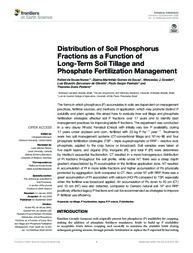Distribution of Soil Phosphorus Fractions as a Function of Long-Term Soil Tillage and Phosphate Fertilization Management.
Distribution of Soil Phosphorus Fractions as a Function of Long-Term Soil Tillage and Phosphate Fertilization Management.
Author(s): NUNES, R. de S.; SOUSA, D. M. G. de; GOEDERT, J. W.; OLIVEIRA, L. E. Z.; PAVINATO, P. S.; PINHEIRO, T. D.
Summary: The forms in which phosphorus (P) accumulates in soils are dependent on management practices, fertilizer sources, and methods of application, which may promote distinct P solubility and plant uptake. We aimed here to evaluate how soil tillage and phosphate fertilization strategies affected soil P fractions over 17 years and to identify best management practices for improving labile P fractions. The experiment was conducted in a very clayey Rhodic Ferralsol (Oxisol) with initially very low P availability, during 17 years under soybean and corn, fertilized with 35 kg P ha?1 year?1 . Treatments were two soil management systems (CT-conventional tillage and NT-no-till) and four phosphate fertilization strategies (TSP ? triple superphosphate or RRP ? reactive rock phosphate, applied to the crop furrow or broadcast). Soil samples were taken at five depth layers, and organic (Po), inorganic (Pi), and total P (Pt) were determined by Hedley?s sequential fractionation. CT resulted in a more homogeneous distribution of Pi fractions throughout the soil profile, while under NT there was a steep depth gradient characterized by Pi accumulation in the fertilizer application zone. NT resulted in accumulation of Pi in more labile fractions and higher accumulation of Po physically protected by aggregation, both compared to CT. Also, under NT with RRP, there was a great accumulation of Pi associated with calcium (HCl Pi) compared to TSP, especially when the fertilizer was broadcast applied. An accumulation of Po down to 20 cm (CT) and 10 cm (NT) was also detected, compared to Cerrado natural soil. NT and RRP positively affected legacy P fractions and can be recommended as strategies to improve P fertilizer use efficiency. Keywords: no-tillage, P fractionation, legacy P, P source, P distribution
Publication year: 2020
Types of publication: Journal article
Unit: Embrapa Cerrados
Keywords: Fixação de Fósforo, Fósforo, Plantio Direto
Observation
Some of Embrapa's publications are published as ePub files. To read them, use or download one of the following free software options to your computer or mobile device. Android: Google Play Books; IOS: iBooks; Windows and Linux: Calibre.
Access other publications
Access the Agricultural Research Database (BDPA) to consult Embrapa's full library collection and records.
Visit Embrapa Bookstore to purchase books and other publications sold by Embrapa.

